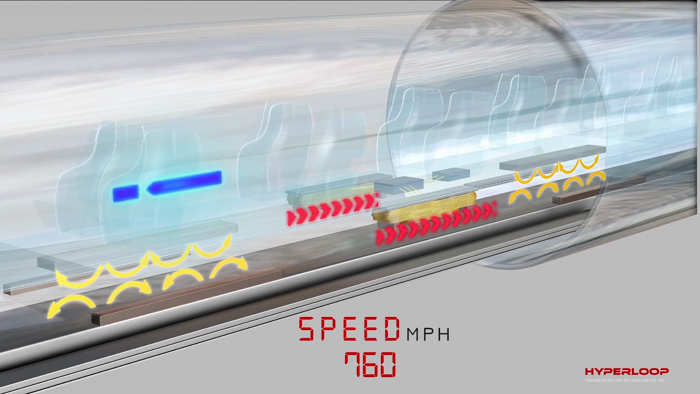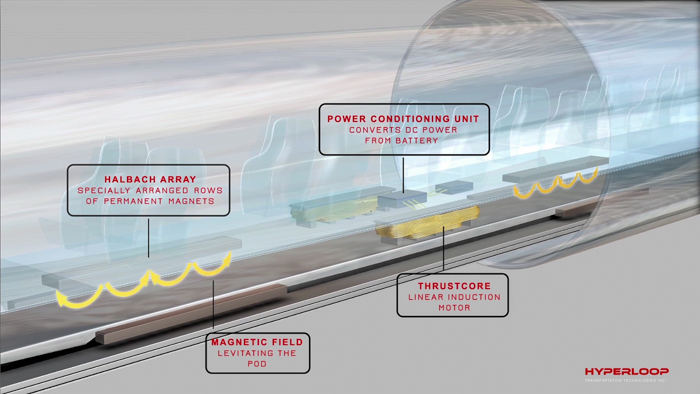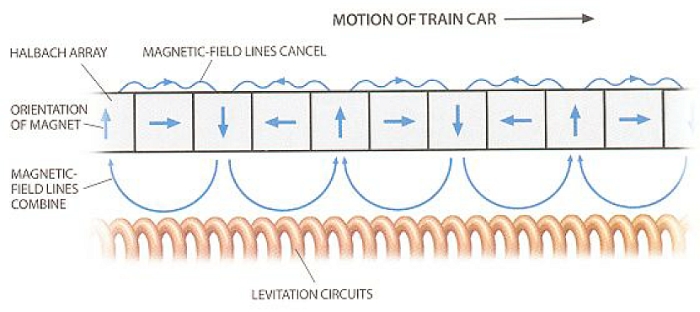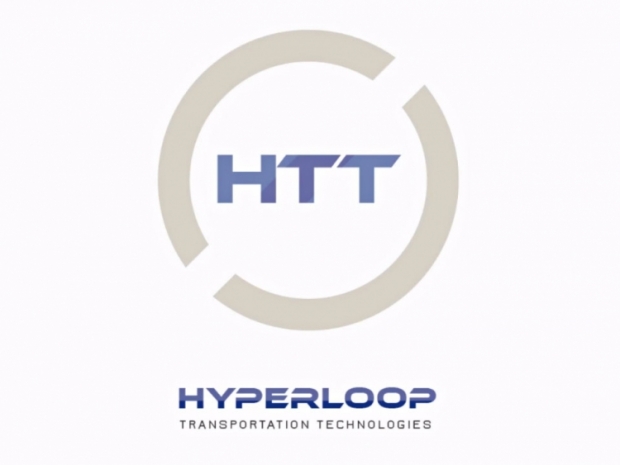
Hyperloop: Mag Thrust With Inside Tube
Over the past year, HTT and Lawrence Livermore National Laboratory (LLNL) have been collaborating on building and developing hyperloop test systems using passive magnetic levitation. The Jumpstart-funded company is now getting exclusive access to the proposed passive, “fail-safe” electrodynamic magnetic levitation system as an alternative to active magnetic levitation systems like those used in MagLev high-speed rail transport.

Hyperloop: Mag Thrust With Inside Tube
The hyperloop is basically an ultra-high speed monorail system, or “subsonic train,” that places passengers inside of pressurized capsules along a track of reduced-pressure tubes. The tubes feature regularly-spaced air cushions to keep the passenger pods floating through the tubes rather than sitting directly on tracks. It uses a combination of alternative energy sources including photovoltaics, wind energy, kinetic energy, regenerative braking and geothermal power to ensure the system’s sustainability and low cost.
In May 2013, Tesla CEO Elon Musk explained the Hyperloop concept to a “cross between a supersonic passenger jet, an electromagnetic projectile launcher (railgun), and an air hockey table,” claiming the system could work just as effectively both under and above ground.

Hyperloop capsule sketch (via Wikipedia)
Dr. Richard Post is the man responsible for developing the levitation system now being exclusively licensed to Hyperloop Transportation Technologies (HTT), one of three companies with hyperloop tracks, along with Hyperloop Technologies Inc. (HTI), led by Rob Lloyd, and the test track at SpaceX headquarters in Hawthorne, California. Dr. Post was a senior scientist in the energy division at Lawrence Livermore National Laboratory (LLNL) and professor emeritus at UC Davis before his passing in 2015.
"I had the honor of meeting with Dr. Post in 2014 prior to his passing," said Dirk Ahlborn, CEO of Hyperloop Transportation Technologies, Inc. and Jumpstartfund in a press release. "He saw the Hyperloop transportation system as the perfect fit for this technology and was excited to see it become part of the project."
Magnetic fields allow levitation by repelling magnets under the passenger pod
In the original Inductrack train car design, magnets are arranged in a Halbach array so that magnetic field lines get reinforced below the array, but cancel each other out above the array. When the passenger pod or train car moves along the track, the magnets induce currents in the track’s circuits that produce an electromagnetic field. This EMF ultimately repels the magnetic array, causing passenger pod or train car to levitate. The system can lift 50 times the magnet weight.

Original Inductrack magnetic field diagram (January 2000)
The original magnetic Halbach array, named after physicist Klaus Halbach from LLNL, uses regular everyday permanent room-temperature magnets rather than stronger superconducting magnets or electromagnets.
“When the bars are placed in this configuration, the magnetic-field lines combine to produce a very strong field below the array,” according to Dr. Post’s paper titled Maglev: A New Approach published in Scientific American in January 2000. Back then, however, the levitation concept was only designed for a high-speed maglev train operating up to 311mph (500km/h). The technology was also designed for launching rockets off a sloping one-kilometer long track prior to orbit.
In March, we wrote that Hyperloop Transportation Technologies signed a deal with the Slovakian government to eventually bring the high-speed subsonic rail to three Central European countries. The track will link the cities of Vienna, Bratislava and Budapest in just 8 minutes between the first two cities (201 kilometers / 125 miles), and 10 minutes between the second two cities (80 kilometers / 50 miles). The first section of the project expected to be completed by 2020.

Hyperloop test track in Quay Valley, California
Meanwhile, the company is spearheading a test track project in Quay Valley, California that it hopes to have running by 2018.
"Utilizing a passive levitation system will eliminate the need for power stations along the Hyperloop™ track, which makes this system the most suitable for the application and will keep construction costs low," said Bibop Gresta, COO of Hyperloop Transportation Technologies. "From a safety aspect, the system has huge advantages, levitation occurs purely through movement, therefore if any type of power failure occurs, Hyperloop pods would continue to levitate and only after reaching minimal speeds touch the ground."


